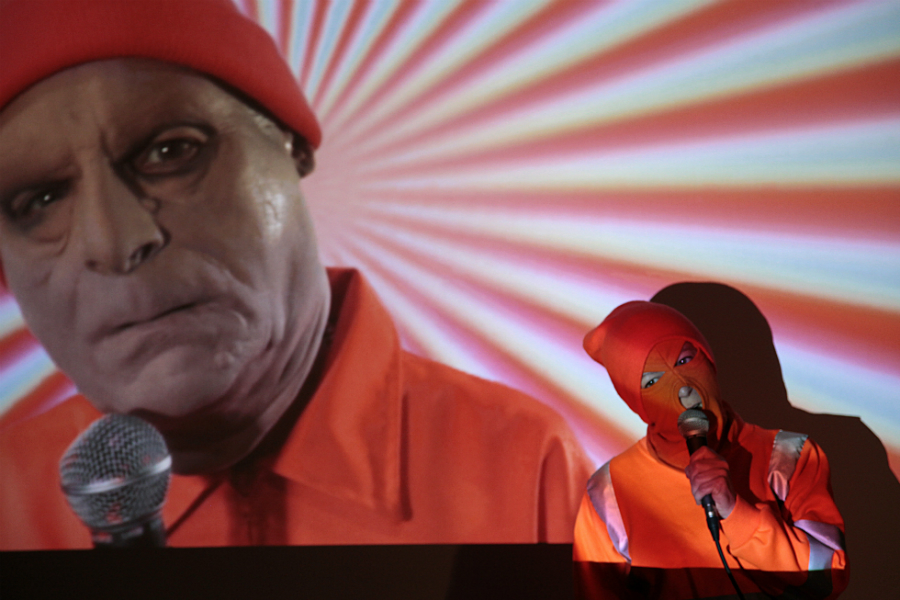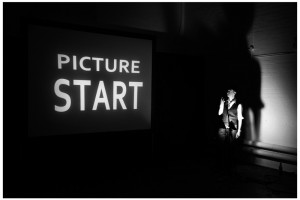Reactor Halls: The Dark Horse Moving Picture Show

Sex dolls, The Sooty Show and super 8: Richard Whitby gets sucked into a nightmarish version of children’s TV in Nottingham’s newest arts space…
Featuring works by Jennet Thomas, Paul Tarragó and Leo Chadburn (aka Simon Bookish), artist collective Reactor’s live art experiment Reactor Halls E11: The Dark Horse Moving Picture Show was a mixed bill of video, film, performance, music and a quiz (with prizes). The last in a series of ‘events that embrace the live situation’, it was held at the group’s studio space in Primary, a former primary school turned new art space in Lenton, Nottingham.
A classroom seemed an appropriate setting for this hospitable but also self professedly ‘dark’ programme – traffic between the worlds of adult and childish understanding being a common device in the works.
Chadburn (aka Bookish) performed several excerpts from his 2007 album Trainwreck/Raincheck, songs composed from transcriptions of dreams. His opening track features the narrator pretending to be a train driver, only to be foiled by not knowing how to open the doors, and a vignette in which a sea captain explains (via an OHP display) that his luxury yacht is going to travel on the back of another, “piggy-back style”. In another song he tells us “My father and I have a ridiculously melodramatic argument – we are both Laurence Olivier doing Greek tragedy”, and relays a story of the appearance of unexpectedly clichéd-looking aliens that provoke “mocking laughter”. The songs are spoken and sung by Chadburn – tall and dark-suited – over an electro-pop backing track, and occasionally augmented by luminous new visuals by Thomas (a former Guardian Artist of the Week).
Thomas’ own works include her film Sharony (2000), in which two young girls dig up a plastic doll in their garden and incubate it in a doll’s house lined with pornography, until she grows into a life-size sex doll. They question her – “We want to ask you about suction moulding”; “What’s it like to be as close to nothing as you?” – take her to a disco and then string her from the ceiling and chop her up. Partly due to the amazing performances Thomas gets from her young actors, this work has an insidious but bleakly familiar horror to it.
Thomas also performed I Am Your Error Message, which – in a caustic manner common to her recent work – satirises contemporary power structures, this time in a mixture of bogus evangelistic sales pitch and software jargon. Masked, she said to the audience: “You must complete the action or you will not be saved!” The work was full of queasy phrases; pronouns and slippery terms without direct referent, horribly suggestive of advertising and political PR.

Tarragó’s pieces included the latest instalment of his Paul and the Badger series, The Seven Wonders (2013), which stars the artist and a cast of hand puppets in a tender pastiche of children’s television. This episode deals with wondrous events (such as the animate but ultimately disappointing ‘space pencils’) and questions of originality and copying. ‘Professor Griddle’, a lauded (human) filmmaker, makes an experimental, visually abstract remake of Casablanca and the puppet Soo (voiced by Jennet Thomas) is barred from appearing on screen by the makers of The Sooty Show, from which the character originates. This film is disarming in its whimsy and humour, but is also extremely detailed and carefully made, and displays a belief in the potential of small, intimate narratives exploring larger critical and emotional issues.
Later in the evening, Tarragó also delivered a spoken performance with analogue slides and super 8 film. His narration extrapolated from the apparently appropriated analogue images, and later tells about film lab workers experiencing a form of synaesthesia after inhaling a chemical by-product of film processing. By way of introduction, Tarragó had explained that the process of making slides and super 8 means that the pieces of film that he is projecting here were physically present, themselves, at whatever event they record – a point that succinctly marries up the technical and philosophical trajectory of Tarragó’s enquiry.
The tone achieved amounts to an odd hospitality, rather than the poker-faced professionalism of many programmes in contemporary art galleries and academies. The event felt a bit like a family ritual that one has inadvertently wandered into. Tarragó – apparently the most willing MC – even does a weird magic trick involving a tape measure, a member of the audience and some confusion between metric and imperial measurements.
Two evenings before the event, I went to see a friend perform at a stand-up comedy night – a relatively new pursuit for him and the first time I’d seen him perform. I was nervous about seeing him live, and the inevitable debrief afterwards, and to add to this when I arrived (late) I realised his whole family were there to watch too. When we took our seats in the packed venue, it turned out that we were seated on the stage itself, facing the performers sideways. Whilst watching The Dark Horse Moving Picture Show (sat a bit too near the front) I thought back to this previous evening, to the skewing of the format of stand-up through my physical position in the room and also the particularities of my personal relationships there.
The weirdness and absurdities of that evening, I guess, were obstructive to the aim of the routines, which was to entertain. The works in The Dark Horse Moving Picture Show purposefully ‘skew’ themselves, into satire, comment and surrealism. And unlike my previous night of stand-up, the showing of the works seemed as much for the artists’ own benefit as for the pleasure of the audience. The presentation revelled in its awkwardness; the slightly-too-long pauses between sentences; the fact that few in the audience seemed to want to win the prizes awarded at the end of the quiz-finalé.
As a whole, the works seemed to propose the domestic as a mode of production, and therefore also as a conceptual space. This is a long-standing concern for Thomas and Tarragó, who once worked together on an exhibition called We Make Our Own Television (2006-2007). Of course, there is a political dimension to all this – one particularly feels the history of punk and feminism. The work put me in mind of satirist Armando Ianucci, writer/filmmaker BS Johnson, musicians Kevin Blechdom and PLANNINGTOROCK, and filmmaker Guy Maddin, as much as other visual artists (often overtly referenced) like John Smith, Erika Beckman and Mike Kelley.
Two of the artists work within higher education; the other is a trained composer who also works with large orchestras. The specialist training and knowledge that is prerequisite to working with institutions such as these is abundantly evident in the works here, yet this particular structure is quite clearly of a very different kind – this is self-organised, small-scale, and wilfully odd and tangential.
Richard Whitby
Images: Reactor Halls E11: The Dark Horse Moving Picture Show, courtesy Julian Hughes
More on Reactor news and events here
With thanks to Niki Russell





